Military police


Military police(MP) arelaw enforcement agenciesconnected with, or part of, themilitaryof a state. In wartime operations, the military police may support the main fighting force withforce protection,convoy security,screening,rearreconnaissance,logistictraffic management,counterinsurgency,and detainee handling.
In different countries it may refer to:
- A section of military forces assigned to police, or garrison, occupied territories, usually during a war.
- A section of military forces assigned to policingprisoners of wardetentions.
- A section of the military responsible for policing the areas of responsibility of thearmed forces(referred to asprovosts) against all criminal activity by military or civilian personnel
- A section of the military responsible for policing in both the armed forces and in the civilian population (mostgendarmeries,such as theFrench Gendarmerieor theSpanish Guardia Civil)
- A section of the military solely responsible for policing the civilian population (such as theRomanian Gendarmerieor theChilean Carabineros)
The status of military police is usually prominently displayed on thehelmetorpeaked cap,with anarmband,brassard,or arm or shoulder flash. Military police personnel may also wear a more traditionalpolice badge,usually on the front of their uniform; They may also wear other accoutrements exclusive to military police personnel.
Naval police personnel are sometimes called "masters-at-arms"and/or"shore patrol".Law enforcement personnel of an air force are sometimes called"air police","security police"or"security forces".
Military police forces by country[edit]
Americas[edit]
Brazil[edit]
"Military police"is a law enforcement agency which follows the Brazilian military rules, responsible forpreventative policingof the civilian population. Each state has its own Military Police department, each one is aGendarmerie.However, and despite their name, these corps are not branches of the Brazilian armed forces, instead, they are auxiliary forces and Brazilian army reserves, alongside also the Military Fire Brigades.
TraditionalProvostduties are held by different corps within each branch of theBrazilian Armed Forces:Army Police(Polícia do Exército, PE) for theArmy,Navy Police (Companhia de Polícia do Batalhão Naval), part of Brazilian Marines, for theNavy,and Air Force Police (Polícia da Aeronáutica, PA) for theAir Force.
Canada[edit]
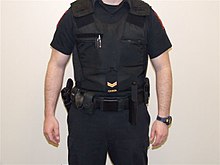
TheCanadian Forces Military Police(CF MP) contribute to the effectiveness and readiness of theCanadian Forces(CF) and theDepartment of National Defence(DND) through the provision of professional police, security and operational support services worldwide.[1]
CFMP are classified aspeace officersin theCriminal Code,[2]which gives them the same powers as civilian law enforcement personnel to enforceacts of Parliamenton or in relation to DND property or assets. They have the power to arrest anyone who is subject to theCode of Service Discipline(CSD), regardless of position or rank, under theNational Defence Act.MPs have the power to arrest and charge non-CSD-bound civilians only in cases where a crime is committed on or in relation to DND property or assets, or at the request of theminister of public safety,commissioner of the Correctional Service of Canadaorcommissioner of the Royal Canadian Mounted Police.Although MP jurisdiction is only on DND property, any civilian accessing these areas falls under MP jurisdiction and is dealt with in the same manner as by any civilian policing agency. If MPs deem that a person, military or civilian, has committed a crime on or in relation to DND property or assets, they have the power to arrest and charge that person under theCriminal Code.The purpose of the CFMP is not to replace a civilian police officer, but rather to support the Canadian Forces through security and policing services.[3][4]MPs also have the power to enforce the provincial highway traffic acts on all military bases in Canada pursuant to the Government Property Traffic Regulations (GPTR).
Colombia[edit]

In Colombia, MPs (Policía Militar in Spanish) are very common. They can be seen guarding closed roads, museums, embassies, government buildings and airports. In theNational Army of Colombiathey are assigned to the 37 Military Police Battalions, wearing green uniforms with the military police helmet. A Naval Police battalion is in service in theColombian Marine Infantry.MP units also providemilitary bandsanddrum and bugle corpsfor ceremonial events. The Air Force also has a military police force (Policía Militar Aérea) that is in charge of protecting and enforcing law insideColombian Air Forcebases.
United States[edit]
Each branch of theUnited States Armed Forces(except theUS Space Force) maintains its own police force. TheU.S. Coast Guard,which in itself is a law enforcement agency, uses a mixture of enlisted rates and ranks qualified as law enforcement officers to patrol, investigate crimes, and enforce laws and regulations on large bases and training centers through theUnited States Coast Guard Police.The Coast Guard also uses theCoast Guard Investigative Service(CGIS), a mixture of civilian, enlisted, reservists, and officers who are qualified and duly sworn federal law enforcement officers separate from the normal Coast Guard chain of command. CGIS primarily investigates and charges those in its own population with serious crimes, such as rape, assault or forgery, that fall under theUniform Code of Military Justice(UCMJ).
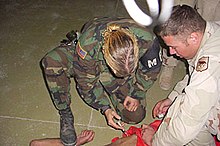
The following is a list of military police forces:
- Military Police Corps/Office of the Provost Marshal General—United States Army
- Provost MarshalOffice (base law enforcement) andlaw enforcement battalions(combat support or "field MPs" )—United States Marine Corps[5][6][clarification needed]
- Masters-at-Arms(MAs) areenlistedsailors of theU.S. Navy,designated as Naval Security Force (NSF), primarily responsible for law enforcement and force protection. NSF personnel are led by naval commissioned officers from thelimited duty officer(LDO) andchief warrant officer(CWO) communities, who are also designated as NSF. Additionally, a host installation's security force (both overseas and in the continental United States) are augmented by sailors on temporary assignment of duty (TEMADD) from their parent units, as part of the Auxiliary Security Force (ASF).Shore patrolpersonnel are sailors from U.S. naval vessels visiting foreign ports (and some domestic ports) assigned to the shore patrol party or beach guard, responsible for the good order and discipline of sailors from the visiting ship(s) on liberty. Sailors assigned to the shore patrol party or beach guard detachment do not include sailors assigned to the ship's security force, both performing different duties while visiting that country, because of the status of force agreement (SOFA) or rules of engagement (ROE). Prior to the 1970s,master-at-armsandshore patrolwere used synonymously to refer to sailors assigned to perform law enforcement and shore patrol duties.[7]
- United States Air Force Security Forces(formerly known as Military Police, Air Police and Security Police)—United States Air ForceandUnited States Space Force
TheUnited States Constabularywas a gendarmerie force used to secure and patrol theAmerican occupation zone in Germanyimmediately afterWorld War II.
Africa[edit]
Algeria[edit]
TheAlgerian People's National Armed Forceshas maintained military police units since its founding upon Algerian independence in 1962. The task of the Algerian military police is to maintain law and order within units and hunt down conscripts trying to flee military service, protect and secure military installations, and organize and move large combat units. In the 1990s, three military police battalions were established as combat units, and they have taken part in combat operations.[8]
Botswana[edit]
TheBotswana Defence Forcemaintainsprovoststo enforce order within the ranks who are authorized to carry out arrests and to order other service personnel to arrest someone. Soldiers and officers suspected of committing offenses may be arrested by military personnel of superior rank. An officer may be arrested by another officer of superior rank, while soldiers may be arrested by any officer, warrant officer, or non-commissioned officer.[9]
Arab Republic of Egypt[edit]

TheEgyptian Armymaintains aMilitary Police Corpsconsisting of 24 battalions, divided into 12 Inland MP battalions (222nd, 224th, 226th, 228th, 230th, 232nd, 234th, 236th, 238th, 240th, 242nd, 244th) and 12 Field MP battalions (221st, 223rd, 225th, 227th, 229th, 231st, 233rd, 235th, 237th, 239th, 241st, 243rd).
Kenya[edit]
TheKenya Armymaintains a Military Police Corps which consists of two battalions and the School of Military Police.
Morocco[edit]
TheRoyal Moroccan Gendarmerie,a part of theRoyal Moroccan Army,is directly subordinate to the Ministry of Interior. It is divided into 22 Regional Gendarmeries, a Mobile Gendarmerie, Air Gendarmerie, and Maritime Gendarmerie.
Nigeria[edit]
TheNigerian Armymaintains a military police force, the Nigerian Army Corps of Military Police (NACMP). It is responsible for protecting installations, guarding important personnel as well as military convoys and prisoners, and investigating crimes. Nigerian military police personnel are divided into three fields, and all MPs are required to specialize in at least one: criminal investigations, general policing duties, andK9handling.[10]
Asia[edit]
Kingdom of Cambodia[edit]
TheGendarmerie,or "Military Police", known as the Royal Gendarmerie ofCambodiais a paramilitary unit with about 7,000 soldiers deployed in all provinces. It is headquartered inPhnom Penh.The unit's chain of command is through theRoyal Cambodian Armed ForcesHigh Command.
The Royal Gendarmerie of Cambodia is deployed in every province and cities to keep the law and order. Military police in Cambodia play an important role in Cambodia society, keeping law and order in cities along with the National Police.
China[edit]
The1954 PRC Constitutionstipulates that the President of the People's Republic of China unifies the national armed forces, and the1982 PRC Constitutionstipulates that theCentral Military Commissionleads the national armed forces, in addition to the CPC's insistence on theabsolute leadership of the Party over the military,[11]so the ChinesePeople's Liberation Armydoes not have a military police in the traditional sense. The armed forces, including the various military branches of the PLA and the ChinesePeople's Armed Police,have their ownpolice pickets units.According to the "Chinese People's Liberation Army Police Regulations", Article 7 stipulates that the "military affairs department of the commanding authority shall be responsible for the management of police operations in the region" in units above the regimental level, and shall dispatch and lead the police pickets to perform police duties in accordance with Article 27. Article 4 of the Police Regulation provides that:
The main tasks of policing are
(1) Maintaining military discipline.
(2) Maintaining order in the operation of military vehicles and traffic safety.
(3) To investigate and deal with impersonation of military personnel, military vehicles and military units in accordance with the prescribed authority
(4) To safeguard the image of the army and the legitimate rights and interests of soldiers out in the field
(5) To carry out temporary guard duty.
It can be seen that the duty of the police picket detachment only involves the military personnel, military vehicles military discipline and other issues; while the legal sense of criminal law enforcement or public security administrative law enforcement authority, but belongs to the military procuratorate or military defense department. Cases of counterfeit military personnel, counterfeit military vehicles and counterfeit military units investigated and dealt with in police picketing are transferred to the jurisdiction of local judicial organs. Jurisprudence holds that in general criminal cases (i.e. not including crimes against military duties), military status does not constitute a special subject. According to Article 4 of the Regulations on Handling Mutual Involvement of Military and Local Criminal Cases implemented by the Supreme People's Court, the Supreme People's Procuratorate, the Ministry of Public Security, the Ministry of State Security, the Ministry of Justice and the General Political Department of the PLA on August 1, 2009, the principle of personal jurisdiction is adopted for military personnel (including active duty military personnel, civilian cadres, military civilian personnel, non-active duty public service personnel, military employees, retired personnel managed by the military, and The investigation, prosecution, trial, and execution of penalties for military personnel (including active duty military personnel, civilian cadres, military civilian personnel, non-active duty public employees, military employees, retired personnel managed by the military, and reserve personnel and other personnel performing military tasks) are under the jurisdiction and execution of military defense departments, military procuratorates, military courts, military prisons, etc.; the investigation, prosecution, trial, and execution of penalties for local personnel are under the jurisdiction of local judicial organs. Included in the Chinese People's Armed Police Force sequence of public security border defense, public security fire, public security guard forces on active duty, in accordance with local personnel to determine the jurisdiction. Special Case: The military police unit established by the Chinese People's Liberation Army in Hong Kong is the same as the police picket detachment in terms of carrying out its tasks.
In January 2016, thePolitical and Legal Committee of the Central Military Commissionwas established as part of thedeepening reform of the national defense and military forces.TheBureau of Security of the General Political Department of the Chinese People's Liberation Armywas subsequently changed to theBureau of Security of the Political and Legal Committee of the Central Military Commission,which will assume the functions of investigation, public prosecution and trial of military-related violations with theMilitary Procuratorate of the Chinese People's Liberation Armyand theMilitary Court of the Chinese People's Liberation Army,respectively.
India[edit]

TheCorps of Military Police(CMP) is the military police of theIndian Army.In addition, the CMP is trained to handle prisoners of war and to regulate traffic, as well as to handle basic telecommunication equipment such as telephone exchanges. They can be identified by their red berets, white lanyards and belts, and they also wear a blackbrassardwith the letters "MP" imprinted in red.
Internal policing duties in a regiment (or a station) are handled by theRegimental Police,who are soldiers of the unit who are assigned to policing tasks for a short period of time. They are essentially used to regulate traffic, and can be identified by a black brassard with the letters "RP" embossed in gold or white.
TheIndian Air Forceis policed by theIndian Air Force Police.They can be identified by their white peaked caps, white lanyards and belts (with a pistol holster). They used to wear a black brassard with the letters "IAF(P)" imprinted in red, until 2013. NowIndian Air ForceProvost and Security officers and IAF(P) wear an arm badge.[12]
TheIndian Navyhas theNavy Police,and they can be identified by a black brassard with the letters "NP" in gold, with the state emblem placed in between the N and the P.
Indonesia[edit]

InIndonesia,the institution which solely has the responsibility andauthorityconcerning the maintenance of discipline andlaw enforcementtowards members of theIndonesian National Armed Forces(TNI) is theMilitary Police Command(Indonesian:Pusat Polisi Militer TNIabbreviated "Puspom TNI" ), an institution directly under the auspices of the Indonesian National Armed Forces Headquarters ( "Mabes TNI" ) which heads the three Military Police corps which are the:
- Indonesian Army Military Police Command;(Puspomad)
- Indonesian Navy Military Police Command;(Puspomal)
- Indonesian Air Force Military Police Command(Puspomau)
They are authorised to enforce military law and conductcrime investigationsinvolving active members of the TNI. Other than conducting law enforcement, MPs which are attached to thePaspampresalso conductescortandHonour guardduties for thehead of state,high-ranking military officials, andVVIPs.[13]The Military police are also responsible in supervisingprisoners of war(POWs), controlling military prisoners, arrestingdeserters,managing military traffic, issuing military driving licenses and conduct jointlaw enforcementoperations with thecivilian policesuch as implementingtraffic checkpoints[14]andcrime investigationto take action towards military personnel caught red-handed in violations.[15][16]
In Indonesia, the Military Police does not have authority towardsciviliansas it is the realm of theIndonesian National Police(Polri), and in the other hand, thecivilian Policedoes not have authority to arrest active members of the military, except accompanied by the Military police. If a member of the armed forces is caught red-handed by the civilian police, then the violator will be sent to the nearest Military Police or the Military police would be contacted in order to conduct further legal processes.
TheArmy,Navy,andAir forcehave their own Military Police unit which focuses on their own branches, but any Military policemen from either branch can take action towards military members from a different branch if caught red-handed, then the violator will be sent to the Military police of their branch. The Military Police in Indonesia are known locally asPolisi Militersometimes shortened "PM" or "POM".
Theuniformsworn by the Military police varies for the tri-services. The Army Military Police weardark green,the Navy Military Police wearblue-grayand the Air Force Military Police wearlight blue.Theberetof all of the three Military police corps in Indonesia is the same which isblue,dragged to the left (except those attached to thePaspampreswho wears light blue berets). When wearing camouflage uniform, MPs are identifiable by their whiteaiguillettesandbrassardworn on their upper left sleeve imprinted the word "PM".[17]
Iran[edit]
TheCentral Provost of Islamic Republic of Iran Armyis the police service of theIslamic Republic of Iran Armed Forces.It has authority within all branches of theIslamic Republic of Iran Armyand has seniority over the designated provosts of the "Sea Police" of theIslamic Republic of Iran Navyand the "Air Police" of theIslamic Republic of Iran Air Force.Separately, theGeneral Provost of the Islamic Revolutionary Guard Corpsmaintains police authority over the land, air, and sea branches of theIslamic Revolutionary Guard Corpsand theBasijmilitia.
Israel[edit]

TheMilitary Police Corps(Kheil HaMishtara HaTzva'it),Mem Tzadehfor short, is the military police/provostof theIsrael Defense Forces.It is responsible for investigating crimes committed by soldiers, traffic enforcement among military traffic, arresting soldiers suspected of criminal offenses, assisting officers in enforcing discipline, locating deserters, guarding military prisons, and helping man checkpoints. In times of emergency,enemydetainees are held and sorted by the military police. It is a brigade-sized force commanded by a brigadier general.
The corps has very little civilian jurisdiction and for that reason works in conjunction with theIsrael Policewhen civilians are involved. TheIsrael Border Police,a branch of the civilian police force, is Israel'sgendarmerieequivalent.
The civilian police and military police share a computer database. Suspects apprehended by the civilian police on a civilian charge and wearing civilian clothes turning out to be a deserting or AWOL soldier are turned over to the Military Police.
Japan[edit]
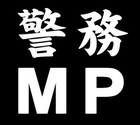

DuringWorld War II,theKempeitaiwere the military police of theImperial Japanese Armyand theTokkeitaiwere the military police of theImperial Japanese Navy.They also performedintelligenceandsecret policefunctions and were active inJapanand its occupied territories.
Today'sJapan Self-Defense Forcesmaintain military police units called the Keimutai (Cảnh vụ đội), with its personnel called Keimukan (Cảnh vụ quan).
Kazakhstan[edit]
TheMilitary PoliceinKazakhstanrefers to law enforcement bodies in theArmed Forces of the Republic of Kazakhstan.The military police is under the joint jurisdiction of theMinistry of Defense,theMinistry of Internal Affairsand theNational Security Committee,all of which manage the activities of the military police.
Mongolia[edit]

TheMongolian Armed Forcesmaintain two law enforcement units. TheInternal Troops of Mongoliais a paramilitary gendarmerie unit that performs special guard and reserve duties. Among other duties, it guards government installations and serves as a riot police force. The032 Military Unitengages in law enforcement as well as organizing daily activities and military supplies and services.
Malaysia[edit]

TheKor Polis Tentera DiRaja(Royal Military Police Corps) performs military police duties in theMalaysian Army.Apart from enforcing discipline and conduct of members of the Army, the Corps oversees security of designated Army installations, performs escort and ceremonial duties, and assists civil law enforcement authorities. TheKor Polis Tenterais also tasked with crime prevention and investigating criminal activities on Army property or by military personnel. With its roots in the BritishRoyal Military Police,members of theKor Polis Tentera DiRajaalso wear the distinctive red peaked cap, white lanyard and belt, as well as a blackbrassardwith the letters "PT" imprinted. PT stands for "Polis Tentera", the Malay words for "Military Police". Military police on traffic duty wear armbands sporting the letters "MP" in red.
Pakistan[edit]
Since the establishment and inception of thePakistan Armed Forces,they have maintained their own military police. The Pakistan Army received its share of Muslim personnel from the former Royal Indian Military Police, forming the Pakistan Army Military Police or "MP". Later, thePakistan Navyestablished the "naval police" with its centre commissioned at "PNS Nighaban", and the Pakistan Air Force later established the PAF Police to maintain order.
ThePakistan Navy's Naval Police can be identified by their red armbands with the letters "NP" written in white. They are headquartered atPNS Qasimin Karachi.
ThePakistan Army's military police is known as thePakistan Army Corps of Military Police.They can be identified by their red armbands, white cross belts and whitecombat helmetswith the letters "MP", written in white.
ThePakistan Air Forceestablished its own military police, known as the "Pakistan Air Force Police" commonly referred to as Provost. The PAF Police can be identified by their red armlets, white cross belts and white combat helmets with "PAF Police" written in red.
The MP, NP and the PAF Police do not exercise any jurisdiction over civilians, nor can the civil courts interfere in the operations of the Military Police. In some cases, the Military Police Corps have worked with civilian police agencies if civilians are involved.
Philippines[edit]
TheArmed Forces of the Philippinescurrently maintains its own military police distinct from the nation'scivilian force,reporting to theChief of Staffthrough the service commanding generals.
The American-established (now defunct)Philippine Constabulary(PC) was also known as theMilitary Police Command.Pursuant to Republic Act 6975 (the DILG Reorganization Act of 1991), the PC and theIntegrated National Policemerged to form the civilianPhilippine National Police,and was placed under theDepartment of the Interior and Local Government.
Saudi Arabia[edit]

Every branch ofArmed Forces of Saudi Arabia(Royal Saudi Land Forces,Royal Saudi Air Force,Royal Saudi Naval Forces,Royal Saudi Air Defense ForcesandRoyal Saudi Strategic Missile Force) have its own Military Police.Saudi Arabian National Guardhas its own Military Police. In theMinistry of Interior,theGeneral Directorate of Border Guard,General Directorate of Public Security,General Directorate of Prisons and Facilities Security Forces each has its own military police. InPresidency of State Security,theSaudi Emergency Forceand Special Security Forces each has its own military police.
The military police of Directorate of Public Security are a small subset and are charged mainly with keeping peace in areas with high levels of aggression and tension.
All the military police wear red berets.
Sri Lanka[edit]
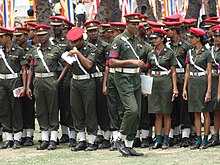
Each branch of theSri Lankan Armed Forceshas its own military police/Provost section. TheSri Lanka Armyis policed by theSri Lanka Corps of Military Policeand byRegimental Police,who belong to each individualregimentsorcorps.
The Military Police force carries out the following missions:
- Maintenance of order and discipline: Consists of monitoring, maintaining and, if necessary, re-establishing discipline and military order. This also involves controlling stragglers and refugees in times of war and guarding and escorting prisoners of war.
- Security missions: Prevents and deters any threat to or attack against the personnel and property of the armed forces. MPs also provide VIP motorcycle escorts and honor guards, perform close protection missions and escort classified documents and money transports.
TheSri Lanka Navyis policed by theProvost Branch.TheSri Lanka Air Forceis policed by theAir Force Police(AFP).
Singapore[edit]
InSingapore,theSingapore Armed Forces Military Police Commandserves as the law enforcement agency of theSingapore Armed Forces.The command is headed by a colonel, otherwise also known as the provost marshal. Its sub-units included the Military Police Enforcement Unit (including Special Investigations Branch and ceremonial and drill components), the Detention Barracks (DB), The 1st Provost Bn, MP Training School and theSecurity Support Forces(including Military working Dog Wing, Close Protection and Security Ops Unit). The command also collaborates closely with theSingapore Police Forcein terms of policing work duties, investigations, etc.
South Korea[edit]

TheRepublic of Korea Armed Forcesmaintains a series of separate military police commands for theArmy,Navy,Air Force,andMarine Corps.ROK Army MPs also function as border guards at theKorean Demilitarized Zone.
Taiwan[edit]

The ROCMP is responsible for enforcing military law, maintaining military discipline, providing backup for the civilian police force or serving as combat troops during times of emergency, providing security for historical sites (such as theCihu Mausoleum) and certain government buildings, including thePresidential Office BuildinginTaipeiCity, as well as performing counter-terrorism and VIP protection operations. The ROCMP are also charged with the defense of the capital Taipei.
Thailand[edit]
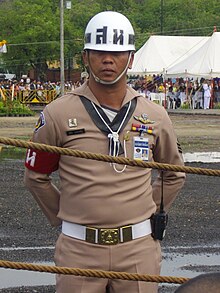
InThailand,each branch of the armed forces has its own military police force. The Royal Thai Navy has the Naval Military Police (สารวัตรทหารเรือ), theRoyal Thai Armyhas the Army Military Police (สารวัตรทหาร), and the Royal Thai Air Force has the Air Force Military Police (สารวัตรทหารอากาศ).
The duties of the Air Military Police Department (กรมทหารสารวัตรทหารอากาศ) are peacekeeping, security, regulating traffic discipline within Air Force installations and housing areas, apprehending deserters, escorting VIPs and investigating crimes under the authority of the Military Court. These investigations include prisoners of war, enemy aliens, refugees and displaced officers within the Air Force and designated areas. It is under supervision of the Commander of the Air Military Police Department.
There is one active Air MP Battalion called the Battalion of Military Air Police (กองพันทหารสารวัตรทหารอากาศ). The Air Military Police Department is one unit under the supervision of the Office of Don Muang RTAF Base Commander (สำนักงานผู้บังคับทหารอากาศดอนเมือง).
- Office of Don Muang RTAF Base Commander[18](สำนักงานผู้บังคับทหารอากาศดอนเมือง)[19]
- Air Military Police Department[20](กรมทหารสารวัตรทหารอากาศ)[21]
- Battalion of Military Air Police (กองพันทหารสารวัตรทหารอากาศ)[22]
Vietnam[edit]
In Vietnam, the Military Police Brigade 144 (Vietnamese:Kiểm soát Quân sự,lit. 'Military Provost') is under the command of theGeneral Staff of the Vietnam People's Army.The military polices are responsible for guarding and protecting thePresidential Palace,government offices and army offices. They are also responsible for supervising military laws on soldiers and officers. Even though the Brigade 144 is the highest level division in the Military Provost force of Vietnam, there seems to be no unified command for the Military Police under the General Staff, the Ministry of National Defense or another General Department within the Ministry. There are several known Military Police units such as the Military Police Battalion 31 of the Ho Chi Minh City Command,[23]the mentioned Brigade 144 of the General Staff, and the Military Police Battalion 103 under the Hanoi Capital Command.[24]Besides the Provost units, there are also the military investigative agencies that function similarly to the Provosts, such as the Criminal Investigation Bureau and the Investigative Security Agency within the Defense Ministry.
Europe[edit]
Armenia[edit]
TheMilitary Police(Armenian:Ռազմական ոստիկանություն; Rrazmakan vostikanut’yun) ofArmeniafall under the command of theMinistry of Defence.The Military Police was established in May 1992, by order of the Minister of Defense. The Military Police is considered a division that is separate from the Ministry of Defense.[25]It had no special status until 2007,[26]when a law to define the Military Police status was adopted. Its status is defined in the RA Law on Military Police. According to the law, the Military Police is responsible for the following:
- Investigation of military crimes in the armed forces that were committed on the territory of military units or by conscripts in military service;
- Deterrence, prevention and stoppage of crimes being planned or committed by military servicemen;
- Protection of property that belongs to the authorized body;
- Proper exploitation and safe operation of vehicles that belong to the armed forces.
The Military Police Bylaws were approved by theGovernment of Armeniaon 25 December 2008.
Austria[edit]

The Austrian Military Police (German:Militärpolizei) of theAustrian Armed Forces(Bundesheer) is located in Vienna and consists of the following elements
- Military Police HQ
- Fundamentals Division
- Training Division
- Signal Platoon
- Close Protection
- 3 MP Companies
- MP Militia
The Military Police has three locations in Austria. The Military Police Command and one MP Co. are located in Vienna. One MP Co. is inGrazand one inSalzburg.
The Military Police is tasked with law enforcement and the protection of the forces, military events and Armed Forces property. The increasing number of international operations in which Austrian soldiers participate and new threat scenarios hugely expand the spectrum of tasks. In addition to its traditional domestic tasks, the Military Police now also fulfill tasks in international operations. In Austria the Military Police is only tasked with internal Armed Forces matters. Abroad, they are tasked with extensive assignments. It closes the security gap between a conflict that has ended and a functioning society. A large number of experienced specialists and modern equipment are required to meet these demanding tasks.

National tasks include:
- Check routines and security checks
- Security duty
- Traffic control
- Close Protection
- Force Protection
- Law enforcement
- Inquiries
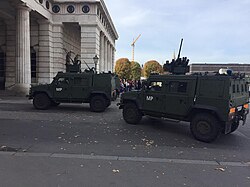
International tasks include:
- Taking down traffic accidents
- Crime scene investigation
- Fingerprinting and photographing
- Interrogations
- Searches/investigations/support in interventions
- Detention of dangerous criminals
- Crowd and riot control
- Operation of detention facilities
- Interventions (Special weapons and tactics –SWAT)
- Close Protection
- Defence against terrorism
Belarus[edit]
The military commandants of theArmed Forces of Belarusare regional administrations responsible for military police on a unit's territory.[27][28]Units are assigned to a specific commandant based on their location. There are 6 military commandants in the Belarusian Armed Forces.[29]
| Commandant Name | Region |
|---|---|
| BaranavichyMilitary Commandant | Brest Region |
| BabruyskMilitary Commandant | Mogilev Region |
| BarysawMilitary Commandant | Minsk Region |
| BrestMilitary Commandant | Brest Region |
| GrodnoMilitary Commandant | Grodno Region |
| Minsk Military Commandant | Minsk Region |
Belgium[edit]

TheBelgian Army's Military Police Group (Groupe Police Militairein French;Groep Militaire Politiein Dutch) performs military police duties on behalf of all four components of the Belgian military. The group is headed by acoloneland has 188 members in five MP detachments. Until 1995, the BelgianRijkswacht/Gendarmeriewas, besides its civilian policing tasks, responsible for the nation's Military Police duties.
The Military Police Group staff is located in the Queen Elizabeth Barracks in theBrusselssuburb of Evere. Alpha Detachment located at Evere covers the province of Flemish Brabant and the capital, Brussels. Bravo Detachment covers the Walloon Brabant,Hainaut ProvinceandNamur Provinceareas and is located atNivelles.Charlie Detachment located atMarche-en-Famennecovers theLiège ProvinceandBelgian Luxembourgareas. Delta Detachment covers theLimbourgandAntwerp Provinceareas and is located atLeopoldsburg.Echo Detachment located at Lombardsijde covers Western and EasternFlanders.
The Military Police force carries out the following missions:
- Maintenance of order and discipline: Consists of monitoring, maintaining and, if necessary, re-establishing discipline and military order. This also involves controlling stragglers and refugees in times of war and guarding and escorting prisoners of war.
- Traffic regulation: Includes traffic monitoring and regulation to ensure the flow of military movements in accordance with plans. This includes route reconnaissance and marking, convoy and oversize vehicle escort and river crossing control. Traffic accident investigations is also a part of the job.
- Security missions: Prevents and deters any threat to or attack against the personnel and property of the armed forces. The Military Police force protects, for example, the Palace of the Nation and the Parliaments and Councils of the Regions and the Communities, headquarters and classified conferences. MPs also provide VIP motorcycle escorts and honour guards, perform close protection missions, and escort classified documents and money transports.
The Belgian Military Police has also taken part in multinational peacekeeping missions such as Afghanistan, Kosovo and the Congo. TheFederal Police'sMilitary Crime Division (DJMM) performs all investigations involving the armed forces.
In 2003, duties relating to refugees and deserters in wartime were transferred from the then disbanded Gendarmerie to the MPs. Members of the former 4 and 6 MP Companies were merged into the new MP Group, along with some Gendarmes previously assigned MP-related duties.
Belgian MPs are identified by black armbands with the letters MP in white block letters, worn on the left arm.
Bosnia and Herzegovina[edit]
Shortly after the formation of theArmed Forces of Bosnia and Herzegovinain 2005, an intentional strategy was made to limit in law and multi-ethnic, crime violation in the armed forces, so to speak, the Military Police, which was formed later on and approved by theMinistry of Defense of Bosnia and Herzegovina.
Bulgaria[edit]
The first documents reflecting the establishment of interior order bodies in Bulgaria are: Instruction on Establishment of Initial Military Police Governorship, dated 3 July 1877, Instruction on the Rights and Duties of the Constituted Local Police Guards, dated 19 July 1877, and Temporary Regulations on Constituting Police Voluntary Sentries and Armed Guards, dated 8 August 1877.
According to the Instruction on Military Police Governorship in the free Bulgarian lands and regions with army presence, the Military Police enforced the law and order in the rear of the army, suspended possible clashes among members of different religious communities and observed for the proper implementation of commanders instructions.
Croatia[edit]

TheCroatianMilitary Police (Croatian:Vojna policija) is a part of theCroatian Armed Forces(Oružane snage Republike Hrvatske). The Croatian Military Police was formed on 27 August 1991, shortly after theNational Guard Corps(Zbor narodne garde) – now theCroatian Army– was formed.
Parts of Croatian Military Police are:
- NSVP – Military Police Education center "Bojnik Alfred Hill"
- 66th Military Police Battalion
- 67th Military Police Battalion
- 68th Military Police Battalion
- 69th Military Police Company
- 70th Military Police Company
- 71st Military Police Battalion
- 72nd Military Police Battalion
- 73rd Military Police Battalion (HRM (Croatian Navy))
- 74th Military Police Company (HRZ (Croatian Air Force))
- 75th Military Police Battalion[30]
Czech Republic[edit]
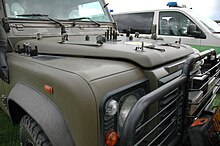
TheMilitary Police Corps (Czechoslovakia)[31](Czechvojenská policie) was set up on 21 January 1991. Within the provisions of the Czechoslovak Law No. 124/1992 Dig. regarding the Military Police, they are responsible for police protection of armed forces, military facilities, military material and other state property controlled by the Ministry of Defence. The Military Police are a professional force. Since 1 January 1993, Czechoslovak Military Police Corps were divided to Czech and Slovak separate Military Police Corps.
The Military Police are headed by a Chief,[32]who directly reports to the Minister of Defence.
As of 1 July 2003, the Military Police officers are equipped with accessories black in colour, including their distinctive feature – the black beret.
The structure is based on the territorial principle. The Military Police subordinated headquarters are located in Prague, Tábor, and Olomouc.
Military police officers are assigned directly to military units, and they form also part of military contingents of the Armed Forces of the Czech Republic in foreign deployments. Foreign Deployments:
The military police officers serve within contingents of the Armed Forces of the Czech Republic on foreign operations on the territory of Iraq and on the Balkans, and as of March 2007 its Special Operation Group (SOG) also in southern Afghanistan in the Helmand Province.
Military Police of the Czech republic also containsactive reserveunits. Members of the active reserve have a civilian profession but several times a year participate in training or other MP activities.
Denmark[edit]
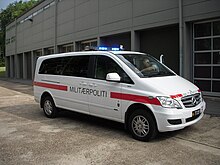
In Denmark the military police (Danish:militærpoliti) services are carried out as independent units under each branch. In thearmyall military police tasks are done as an integral part of theTrænregimentet, [33] whereas thenavymilitary police is an independent unit under command and control of the commanding officer of theDanish Frogman Corps [34] and theair force,as a part of the force protection squadron (Squadron 660) of the air forceCombat Support Wing. [35] Unlike the two other branches, the navy military police also handles installation guard duties (which is carried out by regular soldiers in the army and by an installation protection unit underSquadron 660in the air force) of naval installations as well as certain military installations in the Danish capital region, such as theDanish Defence Commandand theMinistry of Defence.
MP personnel typically wear either branch-specific display dress uniforms with white shoulder markings with the textMPor the branch-common dailycombat uniform,with a redberet.In the air force the MP-shoulder markings is typically replaced with markings saying eitherVAGTorGUARD,but for international missions they also use theMP-markings.
MP personnel generally do not have legal authority over civilians in non-military areas but only over military personnel and on military installations (also publicly accessible places likeHolmen Naval BaseinCopenhagen). On some occasions MP personnel can support civilian police in certain tasks, but will only have slightly more legal authority than civilians—similar to the police home guard.
In the army military police are almost without exceptionNCOsorofficers,whereas the navy and air force rely mainly ofDanish ranks OR-1 to OR-3.
Furthermore, thehome guardhas a police branch, which supports both the civilianDanish policeand the military police.
Typical MP jobs are:
- Installation/perimeter guard
- Personnel protection
- Traffic control
- Courier services
- Prisoner transport
Estonia[edit]
TheSõjaväepolitseiare the Military Police of the Estonian Defence Forces.[1]The Estonian MP organization was created in 1994 and is today divided into tactical (patrol) and investigative units. Additionally, conscript-based reserve MP platoons are trained in Guard Battalion every year. MP tasks include investigation of serious disciplinary cases and some armed service-related crimes, supervision of military discipline within the Forces, military traffic control and various security tasks. Within conflict/crises areas (Afghanistan) the MP may provide close protection of the Estonian national representative and other visiting VIPs. When on regular patrol assignment, Estonian MPs wear a black brassard on their right shoulder, with the lettersSPin silver, and are usually equipped with an HK USP 9 mm pistol, spare magazines, radio, handcuffs, pepper spray and an expandable police baton.
Finland[edit]

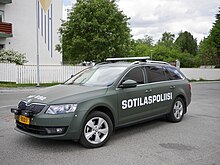
TheSotilaspoliisiare the military police of theFinnish Defence Forces.The Finnish MPs wear a black brassard on the left shoulder with the letters 'SP' in white. A military policeman is usually armed with a 9 mm pistol, a baton, pepper spray and handcuffs on their belt. The military police includes both career and conscript personnel, and is primarily used to guard military installations and supervise military traffic. All military police personnel are trained with basic police techniques and usually receive training forfighting in urban areas.In wartime, the tasks are more extensive and include protection of key personnel and targets, especially against enemy special forces, and surveillance, control, pursuit, arrest and destruction missions. For training, almost all brigades have military police companies. The companies are part of and subordinate to the brigade.
The military police has jurisdiction over military personnel, military areas, installations and exercise areas. However, a military police patrol may stop a crime that it witnesses in process in a civilian area. Additionally, if a military police unit is near to a serious crime taking place, such as a robbery or an assault, and the civilian police are delayed, a military police unit that is near to the scene can offer to handle the situation until the civilian police arrive. As with some other Finnish Defence Forces units, the military police can be used to provide assistance to the civilian police when they are undermanned or lack special resources. In such case, the military police may take measures deemed necessary by the civilian police. For example, during the 2005 Helsinki World Athletic Championship Games, military police conscripts and career personnel were placed along themarathonroute to prevent the large numbers of spectators from obstructing the runners.
Before and duringWorld War II,Finland did not have military police in peacetime, but only temporarysotapoliisi( "war police" ). Ex-police officers were conscripted for police officer duty in the armed forces; usually only the officers had police training. Planning forsotapoliisiwas still unfinished at the break of war, so regular reservists could not be conscripted. Thus personnel had to be recruited without regard to quality; conscripts found unfit for field duty for e.g. health reasons, and even those with previous criminal record were recruited, and the reputation suffered. [36] For a long time,sotapoliisiexisted only in wartime. However, improvement to this came eventually: the military police school was founded in 1963, and civilian police background was no longer required.
The crimes committed by military personnel are, as a rule, investigated by the military. Minor infractions are usually investigated by the career personnel of the unit, while more serious crimes are investigated by the investigative section of the General Staff of the Finnish Defence Forces. In minor matters, the company commander or their superiors may use disciplinary powers, but more serious cases are deferred to the civilian prosecutor who will take the case to the district court.
France[edit]

TheNational Gendarmerieacts as both the military police and one of the two national law enforcement forces ofFrance. Provost missions are assumed by local units for the garrisons of theGround Armyon French soil and by special divisions:
- The 1100 personnel of theMaritime Gendarmeriepolice theNavy(and also acts as acoast guardandwater policeforce). National critical merchant ports are protected by specialized units of the Gendarmerie Maritime, theNaval and Harbor Safety Platoons.[37]
- The 860 members of theAir Gendarmeriepolices theAir Forcefulfills police and security missions in the air bases, and goes on the site of an accident involving military aircraft. This branch is separate from theAir Transport Gendarmerie,which is placed under the dual supervision of the Gendarmerie and the direction of civilian aviation and fulfills police and security missions in civilian airfields and airports. They also perform immigration and emigration checks on military flights.[38]
- The 280 personnel of the Ordnance Gendarmerie (Gendarmerie de l'Armement) fulfill police and security missions in the establishments of the France's defence procurement agency (Délégation Générale pour l'Armement) and ensure VIP close-protection for the head of the DGA and a few other high-rankings.[39]
- The 50 personnel of theGendarmerie of the Safety of Nuclear Armaments,backed by 250 members of theMobile Gendarmeriemonitor all the nuclear armaments of the French Republic.[40]
- The 70 members of theProvost Gendarmerie (Gendarmerie Prévôtale)[41]conduct judiciary and disciplinary investigations in foreign garrisons.
The Maritime Gendarmerie, Air Gendarmerie, Ordnance Gendarmerie and Provost Gendarmerie are placed under the dual supervision of the Gendarmerie and the relevant military branch. However, for judiciary duties, they are under exclusive command of the relevant court.
In addition to the Gendarmerie,Naval Fusiliers (Fusiliers Marins),Fusilier commandos of the Air Force (Fusiliers Commandos de l'Air)and dedicated regimental platoons maintain order for their respective branches.
Germany[edit]

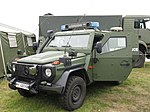
TheFeldjägerare the military police of the GermanBundeswehr.The termFeldjäger( "field hunter" ) has a long tradition and dates back to the mid-17th century. Their motto isSuum Cuique( "To each his own", derived fromCicero,De Finibus, Bonorum et Malorum,liber V,67: "(...) ut fortitudo in laboribus periculisque cernatur, (...), iustitia insuo cuiquetribuendo.").
The first modernFeldjägerunit was activated on 6 October 1955 when the bill creating theBundeswehrwas signed. TheFeldjägercorps serves all component forces of the German Federal Armed Forces (Bundeswehr) i.e.,German Army,German Navy,German Air Force,Zentraler Sanitätsdienst(Joint Medical Corps) andStreitkräftebasis(Joint Support Service). The Military Police Command has its headquarters in Scharnhorst Kaserne inHanoverand is under the operational command of theBundeswehr's Territorial Tasks Commandof theStreitkräftebasis. TheFeldjägerhave three regiments of military police stationed around Germany which are subordinate to the Military Police Command.
Greece[edit]
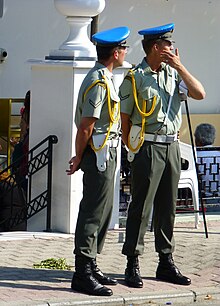
The paramilitaryGreek Gendarmeriefulfilled most security and order duties in Greece untilWorld War II.In 1951, Law 1746/51 established the framework of theHellenic Army'sGreek Military Police(Greek:Ελληνική Στρατιωτική Αστυνομία or ΕΣΑ,Ellinikí Stratiotikí Astynomía). The organization—and particularly its Special Interrogative Department, EAT-ESA—became notorious for its brutality during the 1967–1974military junta.Law 276/76 renamed it simply to "Military Police" (Στρατονομία). Corresponding organizations exist also for other two branches of the Greek armed forces: for theHellenic Air Force(Αερονομία,Aeronomia), founded in 1945 as the Greek Air Force Police (Ελληνική Αεροπορική Αστυνομία, ΕΑΑ), and for theHellenic Navy(Ναυτονομία,Naftonomia,properly Υπηρεσία Ναυτονομίας or Y.ΝΑ.)
These three forces work together often but are independent from each other. Most of the personnel are draftee soldiers undergoing their regular military service.
Hungary[edit]
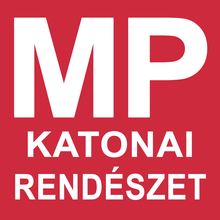
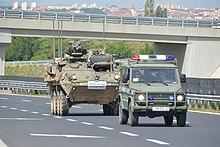
As part of theHungarian Defence Forcesthe Hungarian Military Police (Katonai Rendészet) is a military law enforcement organization with duties of protecting selected objects, investigating accidents involving military vehicles, accompanying military delegations and military forces passing throughHungary,traffic control, personal protection of designated military leaders, performing military police duties in international missions, military law enforcement activities in Hungary.[42]
Ireland[edit]
TheIrish Military Police(colloquially "PA" s, deriving from the official title,Póilíní Airm) are responsible for the prevention and detection of crime in theIrish Defence Forces.Entry to the PA is restricted to serving members of the Defence Forces. All members of the corps are non-commissioned officers, with officers being transferred in for temporary assignments. Unlike many military police services, they retain responsibility for controlling access to many, but not all, military posts. In addition, they provide a military detachment to theOireachtas(Houses of Parliament) and have a large ceremonial role. In the past they had a role in training armed elements of theGarda Síochánabut in recent times this has decreased. Historically, they were responsible for detaining political prisoners inmilitary prisons(until the handing over of military prisons atCork,Spike Island,Arbour Hilland the Curragh to the civil authorities) and in the past occasionally providedfiring squadsfor executions (the last time being theEmergency of 1939–1946).
Italy[edit]
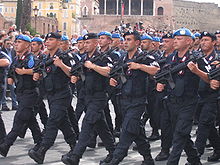
TheArma dei Carabinieriis a gendarmerie force acting as both the military police and one of the four national police forces inItaly.Formed on 13 July 1814, it has been for almost two centuries the senior branch of theItalian Army,until on 5 October 2000 it became a fully independent Service of the Italian military.
With a strength of about 120,000, the Arma dei Carabinieri is a very large organization, including its own air and naval services, but most of its personnel is used for civilian police duties.
The properly Military Police components of the Arma dei Carabinieri are grouped into the "Divisione Unità Mobili Carabinieri" (Carabinieri Mobile Units Division), organized as follows:
2nd Brigade:
- 1st Carabinieri Parachutist Regiment "Tuscania"
- 7th Carabinieri Battalion "Trentino – Alto Adige"
- 13th Carabinieri Battalion "Friuli – Venezia Giulia"
- Gruppo Intervento Speciale.
From these units are drawn most of the elements that form the Carabinieri MP coys, platoons and detachments assigned to all the major Italian Army,NavyandAir Forceunits, as well as many of the personnel forming the MSU Regiments (Multinational Specialist Units) and the IPUs (Integrated Police Units) serving abroad in support of European Union, NATO and United Nation missions. The Arma dei Carabinieri have gained a very good reputation for the professionalism and organization of their MP units in support of international missions, so much that during the 2004 G8 Sea Island Conference the Carabinieri have been tasked to organize and run the CoESPU (Center of Excellence for Stability Police Units), to centralize the training of multinational MP units for international missions.
The 1st Brigade of the same "Divisione Unità Mobili Carabinieri", organized on 11 Mobile battalions and 1 Cavalry Regiment, does contribute to form the same Military Police components as the 1st Brigade, but is mostly tasked toriot controlcivilian police duties.
During someNATOmilitary mission abroad, the Italian carabinieri contributed to military police operations with theMultinational Specialized Unit.
TheGuardia di Finanzaacts as a specialized Military Police force when called upon. Its normal duties include being a force acting in border control, customs duties, and police investigations into financial crimes and illegal drug trafficking.
Netherlands[edit]
In theNetherlands,the function of military police is performed by theKoninklijke Marechaussee( "Royal Constabulary" ), a separate branch of themilitaryindependent of theArmy,NavyandAir Force.Besides performing military duties, theMarechausseeis also a gendarmerie force.
The wordMarechausseeseems to derive from the old French nameMarecheauxgiven to an ancient court of justice in Paris called the "Tribunal of Constables and Marshals of France". These constables and marshals were to become members of the Gendarmerie, which served as a model for the police forces of both Belgium and the Netherlands. The termMarechausseewas also used for theContinental Army's military police during theAmerican Revolution.
Norway[edit]
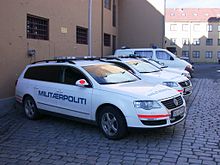

InNorway,military police are service members of theNorwegian Army,Royal Norwegian NavyorRoyal Norwegian Air Force.Since about 2002, all are trained atSessvollmoen Camp.MPs in the Army are assigned to the Military Police Battalion, located at Bardufoss,Tromscounty. The first battalion commander and provost marshal of 6. division Norwegian Army was Maj M Langvik, the currentbattalioncommander is Lieutenant Colonel Jan Henry Norvalls. The battalion consists of approximately 50 officers and NCOs, and 150 privates and corporals. Norwegian MPs first go through a six-month selection/educational period, before being assigned to the battalion or to regimental duties with other units for the remainder of their twelve-month service. Norwegian MPs do not have authority over civilians, except on or in the vicinity of military installations, vehicles or other property or undermartial law.They do have authority over military personnel, including in certain circumstances reservists, anywhere, including when such personnel are off duty.
TheHeimevernet( "Home Guard" ) also has MPs in its ranks. Usually each District (regiment) has one or two platoons, consisting exclusively of former regular or conscript military police personnel.
Norwegian MPs wear a red beret and a red lanyard around the left shoulder extending to the left front pocket. Only personnel currently serving as MPs are allowed to wear this. When on official duty, they also wear the MP armband, which is black with "MP" in red letters. It was previously worn on the right shoulder but is now worn on the left shoulder, followingNATOpractice. They can also wear white webbing, or a number of items for special duties, like high visibility vests for traffic duty, or as mounted personnel while performing motorcycle escort for the Royal Family or their official guests, etc.
Army canine units are also assigned to the MP battalion, but the personnel in such units are not necessarily MPs. Such personnel do not hold military police authority, and do not wear the MP insignia.
MPs have no other powers over civilians than ordinary members of the public, except inside, or in the immediate vicinity of military installations. More serious cases, like narcotics, are handed over to civilian police for investigation.
Poland[edit]
TheMilitary Gendarmerie(Żandarmeria Wojskowa,ŻW) are the MPs for the entirePolish military,established in the 1990s.
Portugal[edit]

InPortugal,each branch of the Armed Forces has its own military police force. ThePortuguese Navyhas thePolícia Naval(Naval Police), thePortuguese Armyhas thePolícia do Exército(Army Police), and thePortuguese Air Forcehas thePolícia Aérea(Air Police). The Air Police is an arm of its own inside the Air Force, but the Army Police is only a speciality of thecavalryarm and the Naval Police is a unit of the Marine Corps (Fuzileiros). A military criminal investigation police, common for the three branches of Armed Forces, also exists, this being thePolícia Judiciária Militar(Military Judiciary Police), that is under the direct dependency of theMinister of National Defense.
Portugal, also, has a gendarmerie type force, theGuarda Nacional Republicana(GNR, National Republican Guard), that is a special corps of troops that executes both civil public security missions and military missions. In time of peace, GNR is under operational command of the Minister of Internal Affairs, but in time of war it can be put under the command of the Armed Forces. GNR is not tasked with enforcing the law within the Armed Forces.
Included in the Portuguese Navy organization also exist two special police forces. The first one is thePolícia Maritima(Maritime Police), that serves as a coast guard and maritime law enforcement agency in the scope of the civil role of the Portuguese Navy as the National Maritime Authority. The other one is thePolícia dos Estabelecimentos da Marinha(Navy's Establishments Police), a small gendarmerie type agency responsible for guarding theLisbon Naval Baseand some other naval facilities.
Romania[edit]
InRomania,theRomanian Military Police(Poliția Militară) carries out police duties for theRomanian Armed Forces.It usually handlesmilitary securityand military crimes and it has national jurisdiction. The Romanian military police is organized in four battalions (two of them are headquartered inBucharest,one inIașiand one inTârgu Mureș).
TheRomanian Gendarmerie,although a military force with national jurisdiction, is not tasked with enforcing the law within the armed forces (in contrast to the French Gendarmerie, which acts as both military and national police force).
Russia[edit]
TheRussian Military Police(Военная полиция России) are the MPs for the entire Russian military. They carry out police duties for theRussian Armed Forces.
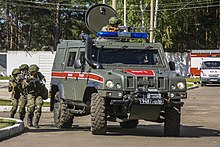
In April 2012 Chief Military Prosecutor Sergei Fridinsky said Russia's military police will be instituted in two stages: first, the integration of the relevant Defence Ministry services and second, granting the new agency investigative functions. In early February 2014 Russian PresidentVladimir Putinsigned into law the Law on Military Police, theState Dumaadopted on 24 January and approved by the Federation Council on 29 January. During consideration of the bill in the lower house of the parliament, presidential envoy to the State Duma Garry Minkh explained that military police has already been created and running, but its activities are governed by departmental orders. President's initiative is aimed at strengthening the legal framework of the forces. On 27 March 2015, Russian President approved the Official Charter of the military police of the Russian Federation.
The Military Police have five main functions:
- Maneuver and mobility support operations
- Area security operations
- Law and order operations
- Internment and resettlement operations
- Police intelligence operations
TheNational Guard of RussiaandFederal Security Servicehas its own military police units.
Serbia[edit]
The Military Police (Serbian:Војна Полиција,Vojna Policija) are considered to be among the best qualified and most combat-prepared organizations within theSerbian military.Their responsibilities include counterterrorist operations, combating organized crime, close protection, securing hostages and search and rescue.
Specific training is provided for members of special units of the Military Police. Drills for Military Police units, from squad to battalion, are based on their anticipated tactical employment, including training in putting down civil disorder. The Military Police Directorate of theGeneral Staffof the Serbian Military is responsible for overseeing the units of the Military Police.
Similar units include:
Spain[edit]


Each branch of theSpanish Armed Forces(Army, Navy and Air Force) has its own military police (Policía Militar,Policía NavalandPolicía Aerearespectively). They are only recognized as constabularies with jurisdiction over military installations, military operations and military personnel. They have jurisdiction over civilians off of military installations likeCivil Guard (Spain).They are also in charge of the security of military installations, play a role as bodyguards of generals, admirals and other relevant military personnel, provide security services to military transports and police military personnel abroad. They have the consideration of authority agents.
The Civil Guard (in SpanishGuardia Civil) is the Spanish gendarmerie force. Along with their civilian law enforcement functions, due to their military nature the Civil Guard is also assigned several functions as a Military Police under theMinister of Defence,the most important of which is Criminal Investigations in military facilities and vessels, other MP functions include traffic and customs enforcement in international missions.
Soviet Union[edit]
TheSoviet Armed Forcesdid not have any units technically named 'military police'. Two separate agencies handled military police duties on a day-to-day basis.[43]
TheKomendantskaya sluzhbaor "Commandant's Service"of theSoviet Armywore a yellow letter "K" on a red patch on the sleeve to indicate their membership of this service—the "de facto" army police.
A second organisation called theTraffic Regulatorsexisted within theRear Services.Traffic Regulators served to control military highway and motor vehicle traffic. Traffic Regulators also wear a white painted helmet with red stripes to indicate their status and either an armband ar patch with the Cyrillic letter "P" (R).
In theSoviet Navyand (later in the present dayRussian Navy) the role ofNaval provostswas primarily filled by personnel from theNaval Infantry.
Sweden[edit]
The Swedish military police are part of theLife Guards,stationed inStockholm.There are two MP companies, the 14th and the 15th companies. The 14th MP company serve a so-called GSS/T contract (two years of service over a period of eight years, the remaining time the soldiers can have a civilian job or study) and the 15th MP company serve a so-called GSS/K contract (hired continually for eight years). The Life Guards are also the seat of the Swedish military police unit (MP-enheten) which is responsible for the education of new MPs and is in charge of all MP activities in Sweden. Part of 13th security battalion, which is a counter-intelligence battalion, is also part of the Life Guards and has some soldiers who are trained MPs (mostly corporals and sergeants).
Switzerland[edit]
In theSwiss Armed Forces,the Military Police is responsible for law enforcement on military property and for all incidents where military personnel or equipment is involved. Unlike, for example, the United States, a military policeman in Switzerland has the same power to arrest any person that has committed an offense he witnessed or if he has reasonable grounds to believe the person has committed a violent offense.[44]
Furthermore, the military police provides protection of Swiss representatives abroad and is in part responsible for the guarding of embassies and foreign VIPs inSwitzerland,as well as maintaining personal security for members of theSwiss Federal Council.In addition, the SwissExplosive Ordnance DisposalCenter is a branch of the MP for the disposal ofunexploded ordnanceand also participates in variousdeminingoperations around the world.
The professional MP units comprise 758 officers and are divided into four Regions, each consisting of two companies and additional groups specialised on criminal investigations and training. The professional MP maintains a standing tactical team, capable of interventions in Switzerland and abroad, headquartered in Bern.[45]In addition, there are four militia MP battalions[46]with a head count of roughly 2000 men. Each MP Battalion has one tactical company who can be called to support either the primary MP tactical team or cantonal police teams if needed.[47]
Unlike regular army personnel, professional military policemen wear olive uniforms in order to provide distinct identification. Militia MP wear the regular Swiss ArmyTAZ 90camouflage. Moreover, the (both the professional and the militia) MP is equipped uniquely, armed withGlockside arms,H&K MP5submachine guns, theMzgw91pump-action rifle and theSG553assault rifle (compared to the standard issueSIG P220pistol andSIG 550assault rifle). Professional MP units drivepatrol carssimilar to those of thecivilian police,but also usePiranhaandDuroAPCs.
Ukraine[edit]
TheUkrainian Military Police(VSP) is the military police for theUkrainian Armed Forces
United Kingdom[edit]
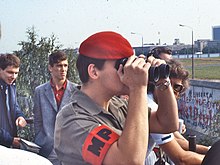
In the United Kingdom the termMilitary Policeusually refers to theRoyal Military Police.The Royal Military Police is the branch of the Adjutant General's Corps, responsible for policing the British Army (both in the United Kingdom and overseas). The termService Policerefers to the three separate police organisations for each of the three branches of the UK's Armed Forces:
- TheRoyal Navyis policed by theRoyal Navy Police(RNP), the members of which are traditionally known as Regulators (orMaster-at-Armsif aChief Petty OfficerorWarrant Officer).
- The Royal Navy Police also providesRoyal Marinesspecialising as service policemen. Prior to 2009, theRoyal Marines Policewas an independent organisation.
- TheBritish Armyis policed by theRoyal Military Police(RMP).
- In addition to the Royal Military Police, most British Army units have their ownRegimental police(RP) andMilitary Provost Guard Service(MPGS) staff. Sometimes incorrectly referred to as Regimental Police, they do not have any police powers or policing function, but are soldiers responsible for discipline within their own units. They are normally located in the Guardroom.
- TheRoyal Air Forceis policed by theRoyal Air Force Police(RAFP). The RAFP provides not only a full Policing function, but they also fulfil a security and counter intelligence function for the RAF and the wider defence community.
In addition, each of the three service police has its ownSpecial Investigation Branch(SIB) to undertake investigation of more serious crime and plain-clothes investigations, and use the jointService Police Crime Bureauoperated by the RNP, RMP and RAFP.
Oceania[edit]
Australia[edit]
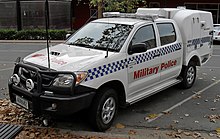
In Australia,Service Policerefers to services policing three different military branches:
- The1st Military Police Battalionis the field component of the Military Police and the Domestic Policing Unit is the garrison policing component. In theAustralian Army,theRoyal Australian Corps of Military Policealso performs the role of a secondary communications network in the front battle zone. Army MP's wear a red shoulder patch with MP in black.
- In theRoyal Australian Navy,theNaval Police Coxswain Branchperforms dual roles of performing general police duties, investigation of criminal offences and a secondary role of ships' coxswain staff responsible for administration of ships' personnel.
- In theRoyal Australian Air Force,the Air Force Police perform the military police role. The Air Force Police organisation falls within Security Forces, therefore their role is largely providing force protection and enforcing military and civilian laws. Air Force Police members wear either a black brassard or patch with white SP meaning Service Police.
The Royal Australian Corps of Military Police train their own working dogs for a more Infantry/combat role.
All major crimes committed by or against personnel of the Australian Defence Force are investigated by theAustralian Defence Force Investigative Service.
New Zealand[edit]
The Joint Military Police Unit (JMPU) is a tri-service Military Police unit from the Navy, Army, and Air Force.
JMPU comprises military police personnel from the Royal New Zealand Navy Naval Police,Royal New Zealand Military Police,and the Royal New Zealand Air Force Police. Personnel still maintain their own single service identity but operate under a singleProvost Marshaland investigate offences against the Armed Forces Discipline Act 1971.
JMPU operates outside of the normal Navy, Army and Air Force command structure. The currentProvost Marshalis aGroup Captainwho reports directly to theVice Chiefof theNZDF.
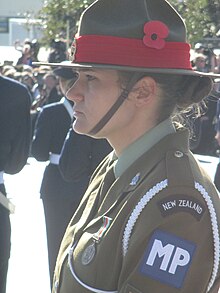
For all serious and complex investigations that are outside the scope of regular Military Police personnel a specialised unit known as the Special Investigations Branch (SIB) handles all high-profile investigations. SIB personnel attend courses with theNew Zealand PoliceCriminal Investigation Branch.SIB have a similar role to theAustralian Defence Force Investigative Service(ADFIS). SIB are also seconded to the NZ PoliceCIB.
JMPU also provide the close protection function for theNZDF.Only personnel from within the unit are able to attend the Tier 1 course and undergo a rigorous selection process. From time to timeNZ Policeofficers from theDiplomatic Protection Squadand theArmed Offenders Squadhave been known to also complete the course.
JMPU complete certain NZ Police courses such as Urgent Duty Driving, Disaster Victim Identification, Basic and Intermediate Crash Investigation with theNZ PoliceSerious Crash Unit,and some personnel have completed theDiplomatic Protection Squadtraining course.
JMPU are responsible for all detainee handling both in peacetime and in an operational environment such as custody and escort ofPOWs.Military Police are responsible for maintaining discipline at the Services Correction Establishment (SCE) which is located atBurnham Military Camp.SCE is theNZDFMilitary Prison and consists of guards who are all serving members of JMPU. The guards are responsible for rehabilitation of service personnel who have been sent to the facility as a result of serious offences committed against the Armed Forces Discipline Act 1971.
JMPU are identifiable by the blue and white "MP" patch they wear on their uniform and the blue beret as head dress, the wearing of theBlue beretdiffers from many commonwealth military police units as traditionally ared beretis worn.
JMPU wear their respective service dress for each service. During peacetime JMPU wear either a Multicam Camouflage uniform, or blue uniform with a SRBA vest.
Air force police[edit]

Air force policeor sometimes known as "Air police" refers to certain units that are part of a country'sair forcethat performlaw enforcementduties such asforce protectionand air patrols, dealing primarily with the enforcement ofaviation lawatair force bases.It also indirectly plays a part in ensuring theair sovereigntyof acountry.It serves similarly to military andparamilitary policeforces around the world and are commonly set up as a branch of a nation's military police or even a separate institution altogether. In some countries, the Air force police are also responsible for conductingProvostduties in the scope of a country'sair force,such as implementingcrime investigationand enforcing discipline/order towards members of theAir force.
By country[edit]
 Royal Australian Air ForceSecurity Police
Royal Australian Air ForceSecurity Police Canadian Forces Military PoliceThe Air Force Military Police Group
Canadian Forces Military PoliceThe Air Force Military Police Group Air Gendarmerie
Air Gendarmerie Indian Air ForcePolice
Indian Air ForcePolice Indonesian Air ForceMilitary Police Command (Puspomau).[48]
Indonesian Air ForceMilitary Police Command (Puspomau).[48] Air Police Group,Japan Air Self-Defense Force
Air Police Group,Japan Air Self-Defense Force Air Force Police,Royal Air Force Regiment
Air Force Police,Royal Air Force Regiment Royal New Zealand Air ForcePolice
Royal New Zealand Air ForcePolice Polícia Aérea
Polícia Aérea Military police of theRepublic of Korea Air Force
Military police of theRepublic of Korea Air Force Sri Lanka Air Force
Sri Lanka Air Force Turkish Air Force
Turkish Air Force Royal Air Force Police
Royal Air Force Police No. 3 (Royal Auxiliary Air Force) Police Squadron
No. 3 (Royal Auxiliary Air Force) Police Squadron United States Air Force Security Forces
United States Air Force Security Forces Venezuela Air ForcePolice
Venezuela Air ForcePolice
See also[edit]
References[edit]
- ^"CFPM - Mission and Vision".Archived fromthe originalon 23 February 2012.Retrieved29 April2012.
- ^Military Police and Reports on Persons in CustodyArchived29 June 2009 at theWayback Machine
- ^"Governance of the Canadian Forces – Military Police"(PDF).6 July 2011. Archived from the original on 6 July 2011.
{{cite web}}:CS1 maint: bot: original URL status unknown (link) - ^"Military Police Powers - DriveSmartBC".www.drivesmartbc.ca.Archivedfrom the original on 16 March 2012.Retrieved30 April2012.
- ^"Corps creates law enforcement battalions - Marine Corps News - News from Afghanistan & Iraq - Marine Corps Times".27 July 2012. Archived fromthe originalon 27 July 2012.
- ^"MCWP 3-34.1 > The Official United States Marine Corps Public Website > Electronic Library Display".1 August 2013. Archived from the original on 1 August 2013.
{{cite web}}:CS1 maint: bot: original URL status unknown (link) - ^"Master-at-Arms Community".Master-at-Arms Community Manager's Page.U.S. Navy.Archivedfrom the original on 26 April 2014.Retrieved30 April2014.
- ^Souaïdia, Habib (7 June 2012).La sale guerre: Le témoignage d'un ancien officier des forces spéciales de l'armée algérienne.La Découverte.ISBN9782707174628.
- ^"BOTSWANA DEFENCE FORCE | Principal Legislation".[permanent dead link]
- ^https://nacmponline.net/about-nacmp-more.php[dead link]
- ^"Đại lực bồi dục đương đại cách mệnh quân nhân hạch tâm giới trị quan".1 December 2014. Archived from the original on 1 December 2014.Retrieved20 December2018.
{{cite web}}:CS1 maint: unfit URL (link) - ^"Reference Book IAF Uniforms"(PDF).Archived fromthe original(PDF)on 2 February 2017.Retrieved18 October2016.
- ^"Military policemen attached with the Presidential Security Force (Paspampres)".YouTube.Archivedfrom the original on 3 August 2021.Retrieved3 August2021.
- ^"Indonesian Military policemen conducting traffic checkpoint".YouTube.Archivedfrom the original on 5 March 2020.Retrieved13 October2019.
- ^"Vision and Mission of the Military police of Indonesia"(in Indonesian).Archivedfrom the original on 13 October 2019.Retrieved13 October2019.
- ^"Military Policemen arrest a soldier involved in criminal offence"(in Indonesian). 13 December 2018.Archivedfrom the original on 13 October 2019.Retrieved13 October2019.
- ^"Video profile of the Indonesian Army Military Police".YouTube.Archivedfrom the original on 29 February 2020.Retrieved13 October2019.
- ^"Office of Don Muang RTAF Base Commander, Bangkok, Thailand".Archived fromthe originalon 29 September 2007.Retrieved16 May2007.
- ^"Office of DonMuang RTAF Base Commander, Welcome to visit Thailand 2005, sunthai homepage group,searchthailand sunthai group, Bangkok today, ของดีเมืองไทย,บัว... ราชินีแห่งไม้น้ำ Water Lily,อากาศยานานุสรณ์ รุ่นต่าง ๆ ของ ทอ., Thailand2006,ฝ่ายเสนาธิการสำนักงานผู้บังคับทหารอากาศดอนเมือง".Archived fromthe originalon 10 April 2007.Retrieved16 May2007.
- ^"Air Military Police Department".Archived fromthe originalon 29 September 2007.Retrieved16 May2007.
- ^"Rtaf,Office of Don Muang RTAF Base Commander,sunthai group, Bangkok, Thailand".Archived fromthe originalon 10 August 2007.Retrieved16 May2007.
- ^"Rtaf,Office of Don Muang RTAF Base Commander,sunthai group, Bangkok, Thailand".Archived fromthe originalon 6 April 2007.Retrieved16 May2007.
- ^Mai Huong."Military Police Battalion 31's troops in hard training".People's Army Newspaper.Archivedfrom the original on 23 February 2023.Retrieved23 February2023.
- ^"Training in Military Police Battalion 103 under the Hanoi Capital Command".en.qdnd.vn(in Vietnamese).Archivedfrom the original on 23 February 2023.Retrieved23 February2023.
- ^"armenia and democratic control of the armed forces - OSCE".Archivedfrom the original on 19 February 2020.Retrieved11 June2020.
- ^"Law of the Republic of Armenia" About military police "".cis-legislation.com.Archivedfrom the original on 11 June 2020.Retrieved11 June2020.
- ^"Парады и порядок — Газета" Минский курьер "".Archivedfrom the original on 23 April 2021.Retrieved22 May2020.
- ^Books, L. L. C. (26 July 2010).Law Enforcement Agencies of Belarus: Militsiya, Belarusian Auxiliary Police, State Security Committee of the Republic of Belarus.General Books LLC.ISBN9781158413461– via Google Books.
- ^"Военные комендатуры Вооруженных Сил — Военный информационный портал Министерства обороны Республики Беларусь".Archivedfrom the original on 19 May 2018.Retrieved18 May2018.
- ^Bajlo, Ivan."Vojska.net - strategy, wargaming, military history website".webarchive.loc.gov.Archived from the original on 4 April 2011.
{{cite web}}:CS1 maint: bot: original URL status unknown (link) - ^"Špatná zpráva".www.army.cz.Archivedfrom the original on 5 March 2009.Retrieved22 February2009.
- ^"Špatná zpráva".www.army.cz.Archivedfrom the original on 5 March 2009.Retrieved22 February2009.
- ^Hærens militærpolitiArchived4 March 2016 at theWayback Machine(in Danish) (Military police of the army)
- ^Fakta om Forsvaret(in Danish) (Facts about the Defence)Archived19 June 2013 at theWayback Machine
- ^Militærpolitiet har mange funktionerArchived1 August 2013 at theWayback Machine(in Danish) (The military police has many tasks)
- ^"Pro gradut".www.hum.utu.fi.Archived fromthe originalon 6 July 2011.Retrieved11 January2022.
- ^"La gendarmerie maritime".Archivedfrom the original on 8 October 2021.Retrieved22 April2018.
- ^"Gendarmerie de l'Air".Archivedfrom the original on 25 July 2021.Retrieved22 April2018.
- ^"La gendarmerie de l'Armement".Archivedfrom the original on 23 April 2018.Retrieved22 April2018.
- ^"La gendarmerie de la sécurité des armements nucléaires".Archivedfrom the original on 28 July 2018.Retrieved22 April2018.
- ^https://www.defense.gouv.fr/actualites/operations/la-gendarmerie-prevotaleArchived3 May 2018 at theWayback Machine[bare URL]
- ^"Katonai Rendészet".honvedelem.hu.[permanent dead link](in Hungarian)
- ^Olley, Simon."Warsaw Pact" Military Police "".home.mweb.co.za.Archivedfrom the original on 3 December 2013.Retrieved18 May2012.
- ^"Fedlex".Archivedfrom the original on 28 May 2020.Retrieved26 April2020.
- ^"Militärpolizei Spezial-Detachement".Archivedfrom the original on 9 March 2021.Retrieved26 April2020.
- ^"Militärpolizei".Archived fromthe originalon 15 March 2020.Retrieved26 April2020.
- ^"Fedlex".Archivedfrom the original on 20 October 2020.Retrieved26 April2020.
- ^"Video profile of the Indonesian Air Force Military Police".YouTube.Archivedfrom the original on 14 April 2020.Retrieved13 October2019.
External links[edit]
![]() Media related toMilitary policeat Wikimedia Commons
Media related toMilitary policeat Wikimedia Commons
